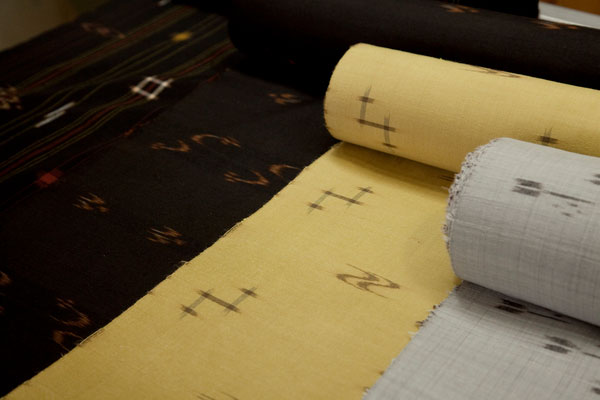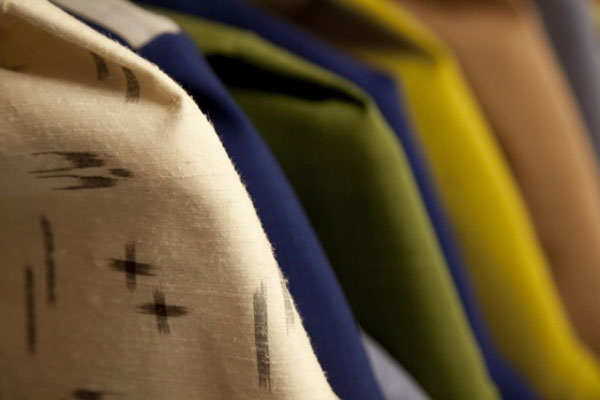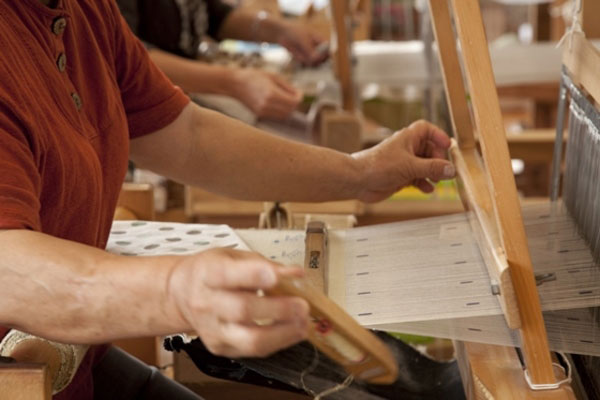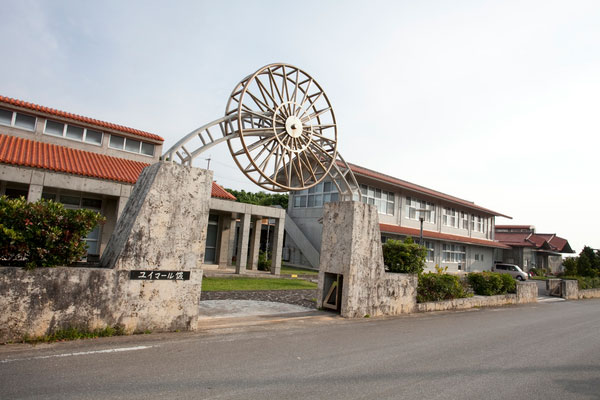 Photo:Okinawa Convention&Visitors Bureau
Photo:Okinawa Convention&Visitors Bureau
- Woven textiles
- Okinawa
Kumejima tsumugi silk Kumejima tsumugi
Created by the history and nature of Kumejima
Precious textile woven by one artisan
Description
What is Kumejima tsumugi silk ?
Kumejima tsumugi silk is a textile produced on the island of Kumejima, Okinawa prefecture. The history of this craft goes back all the way to the Muromachi period (1336-1573).
This textile is distinct because of its elegant texture and deep color tone. The production process includes designing, collecting raw dyeing materials, dyeing the threads and weaving. One weaver completes all of these steps by hand. This craft is made with tsumugi ito (pongee thread) or hiki-ito (hand pulled raw silk thread) and the dye from plants grown on Kumejima Island. Either a plant dye or plant/mud dye method is utilized. Tsumugi threads are twisted and hand-spun silk pulled from unwindable floss silk. Using natural dye means the more this textile is washed, the color gets bright and the texture becomes more beautiful. This is because the harshness of the dye lessens every time the textile is washed.
Kumejima tsumugi has a kasuri* pattern so the threads have to be dyed in fine sections to weave the pattern correctly. The parts of the threads which should not be dyed have to be hand tied with cotton threads in advance which is a technique called kasurikukuri and requires intense concentration.
*A textile technique of securely tying specific sections of fabric with thread so that only certain portions will be dyed resulting in a desired pattern.
History
 Photo:Okinawa Convention&Visitors Bureau
Photo:Okinawa Convention&Visitors Bureau
According to the Ryukyukoku yuraiki (Records on the Origin of the Ryukyu Kingdom), the technology of sericulture was brought from the Ming dynasty in China during the 14th century by Donohiya, head of the Ryukyu Kingdom servants.
At the beginning of the Ryukyu Kingdom in 1511, a severe poll tax began to be enforced on Kumejima Island. People had to present the Tsumugi textile to the Ryukyu government instead of paying with money. However, after the Satsuma domain (now Kagoshima prefecture, located just north of Okinawa) invaded the Ryukyu Kingdom in 1609, a better quality textile was demanded as a heavier poll tax. This is why the Ryukyu royal government invited Hiromoto SAKAMOTO from the domain of Echizen (now Fukui prefecture) in 1619 to introduce better sericulture technology and floss silk production methods. Then, Kagetomo TOMOYOSE from the Satsuma domain brought dyeing and Tsumugi weaving technologies to the island. These events laid the foundation for Kumejima tsumugi to be produced and sent to Edo (ancient name for Tokyo) via the Satsuma domain. At the time, this craft was called Ryukyu tsumugi.
Residents of Kumejima Island continued the production of the Tsumugi textile to pay the poll tax until 1903 when the tax was abolished. Tsumugi textile could finally be developed as a proper industry after a business improvement project started around 1905.
General Production Process
 Photo:Okinawa Convention&Visitors Bureau
Photo:Okinawa Convention&Visitors Bureau
- 1. Spinning thread
Silkworm cocoons are softened through boiling in an alkaline solution.
The threads are pulled out of the cocoons to make a single weft thread (perpendicular thread). Then the pulled threads are twisted vertically and wound around a small tube with a zaguriki (a silk reeling machine). The warp thread (parallel thread) is prepared by floating silkworms in lukewarm water, turning them over and spreading them on the hand to make raw silk made from the waste cocoons. The silk is pulled out from the waste cocoons, twisted lightly by hand, and wound around the tube.
- 2. Designing
The designs come from reference documents. One of the documents is a collection of kasuri patterns that come from maps and designs established by the Ryukyu royal government. Many of the patterns are also based on the natural environment, animals, and plants.
- 3. Kasuri tying
Kumejima tsumugi uses kasuri threads to tie a design, which dyes some of the threads but not the others. The warp threads are starched and wound around a wooden or bamboo frame. Then, the threads are cut to a certain length and sorted into the necessary number of threads. The parts of the threads that do not have to be dyed are marked with charcoal and wrapped in plastic before being tied with cotton threads.
The kasuri pattern will not be properly aligned if the marked positions and the tying positions are inaccurate. Tying the threads too loosely results in the color smearing and a loss in the brightness of the kasuri pattern. On the other hand, if the threads are tied too firmly, the color distinction becomes too harsh which blemishes the gentle kasuri ashi pattern, a cross-like design important for Kumejima tsumugi. This is a process that requires precision and patience in order to make the pattern beautiful.
- 4. Making the standard threads
The starched white cotton threads are set on a picture stand and marked with ink along the design to make the standard threads for the kasuri threads. The weft threads are reeled and their length is adjusted for the standard threads. Then, the standard threads are pulled along the warp threads and tied where marked.
- 5. Dyeing threads
The threads are dyed around September when the temperature drops and the sunlight becomes less harsh. Kumejima tsumugi uses dye extracted from wild plants grown on Kumejima Island. The threads are dyed with pure plant dye collected locally. The colors are reddish black, reddish brown, silvery gray, yellow, and olive green. The type of plant and dye fixing chemical (mordant) determines the color. Using a mordant aids the development and settling of the color into the fiber.
Kuru (a plant of the Japanese yam family) is cut into small pieces and simmered for two to three hours. The threads are placed in the hot liquid and then dried evenly so that there is no irregularity when they are dyed. This process is repeated four to five times a day for ten days.
After the kuru dyeing is complete, the threads are dyed with Indian hawthorn plant. This process is repeated six to seven times a day for approximately fourteen days. Then, if necessary, the dyeing processes are repeated until the threads become dark brown.
- 6. Temporary reed fitting and winding
The warp threads are put through a comb-shaped tool. Then the foundation threads are starched and reeled on a wooden or bamboo frame. They are sorted according to the length and required amount. The warp threads are combed and wound tightly.
- 7. Removing the threads
The cotton threads that tied the warp threads are removed. The threads are starched and stretched. The weft threads are individually separated and wound around the small tube. The foundation threads set the weft threads on the loom.
- 8. Weaving
The warp threads are pulled through between the foundation threads that will be put through the reed. When the warp threads are set, they are pulled one by one along the aze of two heddles. The aze is a tool for lining up the warp and the weft threads. Two threads are put through each eye of the reed. The weft threads are separated one by one and wound around a spinning wheel with the foundation threads to set them in the shuttle.
Then, the weaver starts weaving by throwing the shuttle, putting it through the weft threads, and pulling it toward themself. This process uses a wooden loom. It takes about a month to produce a roll of Kumejima tsumugi.
- 9. Hammering the cloth
The woven textile is folded into a screen-like shape, washed in lukewarm water of about 30℃ (about 86℉), and left out to dry in the sun. When the textile is nearly dry, the weave is aligned and it is folded into the screen-like shape again. The folded textile is wrapped in cotton cloth and hammered using a wooden hammer called a kinuta, which weighs about 4.5 kilos (9.9 pounds) so it requires two people to hold, for about twenty to thirty minutes. This is another important process to create the luster and texture of the tsumugi. Then the textile is again dried in the sun, the creases from folding are smoothed out, and it is complete.
Where to Buy & More Information
Kumejima-Tsumugi No Sato
 Photo:Okinawa Convention&Visitors Bureau
Photo:Okinawa Convention&Visitors Bureau
-
Address
-
Tel.+81-989-85-8333
-
ClosedAround the New Year
-
Business Hours9am to 5pm
-
Website
See more Woven textiles
- Nishijin brocade
- Yuki tsumugi silk
- Kurume traditional resist-dyed textiles
- Ojiya chijimi textiles
- Hakata brocade
- Ushikubi tsumugi silk
- Chichibu-meisen silk
- Miyako ramie textile
- Shiozawa tsumugi silk
- Kumejima tsumugi silk
- Omi ramie cloth
- Ryukyu traditional resist-dyed textiles
- Kiryu brocade
- Murayama-oshima tsumugi silk
- Yumihama traditional resist-dyed textiles
- Chibana-hanaori textiles
- Hon-shiozawa silk
- Oitama tsumugi silk
- Ojiya tsumugi silk
- Yaeyama cotton cloth
- Yaeyama ramie cloth
- Honba oshima tsumugi silk
- Shinshu tsumugi silk
- Shuri brocade
- Tama brocade
- Yomitanzan-hanaori textiles
- Isesaki traditional resist-dyed textiles
- Hachio island silk
- Nibutani bark cloth
- Uetsu tilia bark cloth
- Awa-shijira cotton cloth
- Kijoka banana fiber cloth
- Tokamachi traditional resist-dyed textiles
- Tokamachi akashi chijimi textiles
- Yonaguni brocade
- Yuntanza minsa
- Flower pattern textiles
- Oku-Aizu Showa Karamushi Textiles
See items made in Okinawa
- Tsuboya ware
- Miyako ramie textile
- Ryukyu lacquerware
- Kumejima tsumugi silk
- Ryukyu traditional resist-dyed textiles
- Chibana-hanaori textiles
- Yaeyama cotton cloth
- Yaeyama ramie cloth
- Shuri brocade
- Yomitanzan-hanaori textiles
- Ryukyu traditional textiles
- Kijoka banana fiber cloth
- Yonaguni brocade
- Yuntanza minsa
- Flower pattern textiles
- Sanshin































































































































































































































































































